Going on a “snipe hunt” is a phrase suggesting a fool’s errand so it was appropriate that one of my first subjects yesterday morning at Bear River was a Wilson’s Snipe. Sharp eyes will notice in my image techs that I photographed this bird with one of my older Canon 7D’s instead of my preferred 7D Mark II. That’s because I had inadvertently moved my Multifunction Switch so I couldn’t adjust exposure and I didn’t know why the Mark II wouldn’t function properly. I didn’t figure it out until I was ready to head home. A fool indeed…
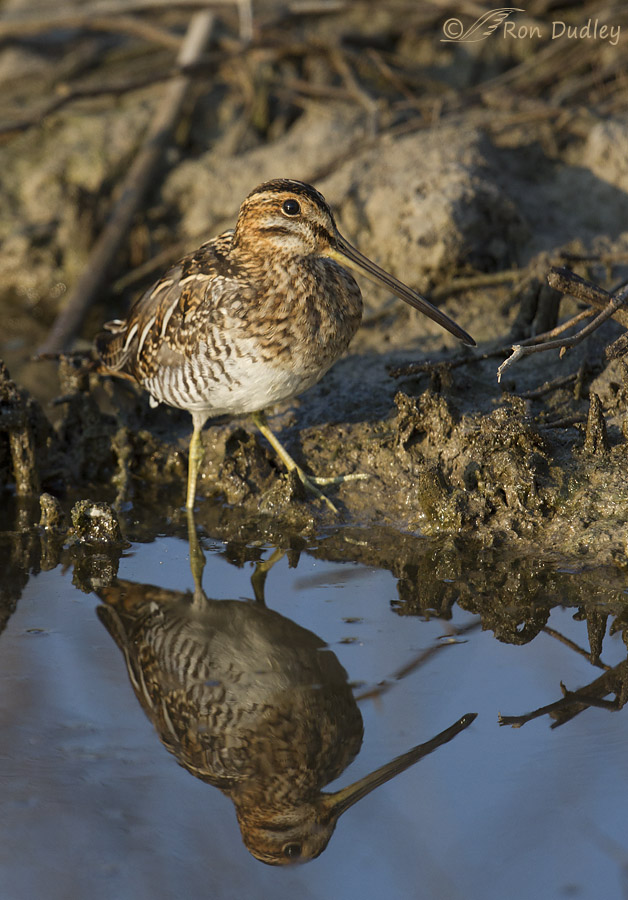
1/1250, f/6.3, ISO 640, Canon 7D, Canon EF500mm f/4L IS II USM +1.4 tc, not baited, set up or called in
Snipes are elusive subjects. The typical view of one is as it flushes in a fast, zigzag flight but when I approached this bird it watched me warily for a short time and then apparently decided I was no threat so it quickly went back to its business of feeding in the mud.
Snipes are odd-looking birds, partly because their eyes are set so far back on their heads. This allows them full vision on both sides and a binocular overlap in the rear so they can detect the approach of a threat with their beak buried in the mud.
I shot this image vertically so I could get the reflection even though it was in shade.
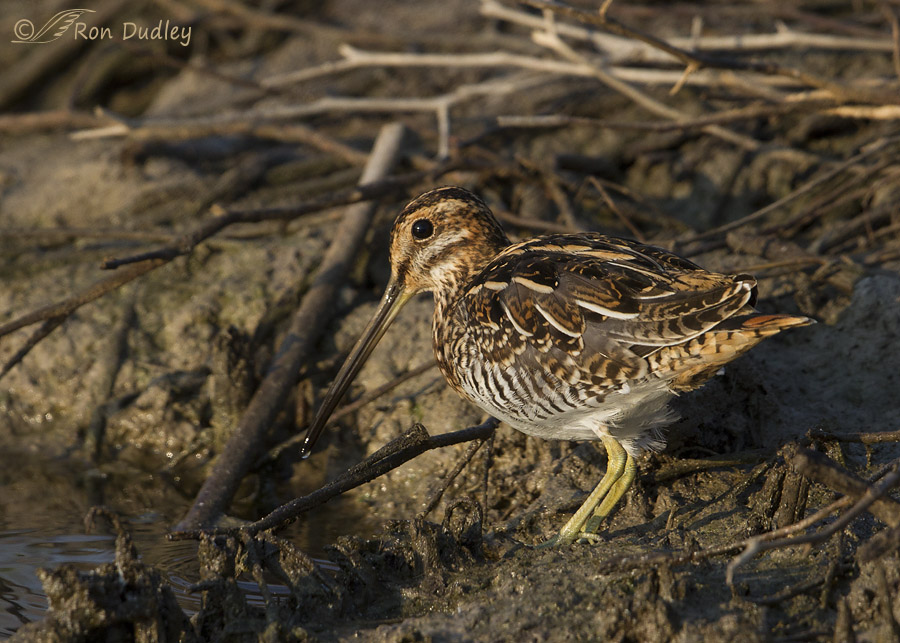
1/1250, f/7.1, ISO 640, Canon 7D, Canon EF500mm f/4L IS II USM +1.4 tc, not baited, set up or called in
The sun was still very low so vegetation shaded most of the setting and the snipe had to turn just right to get good light on it. Here it had pulled its beak up from the water/mud and posed for a moment before…
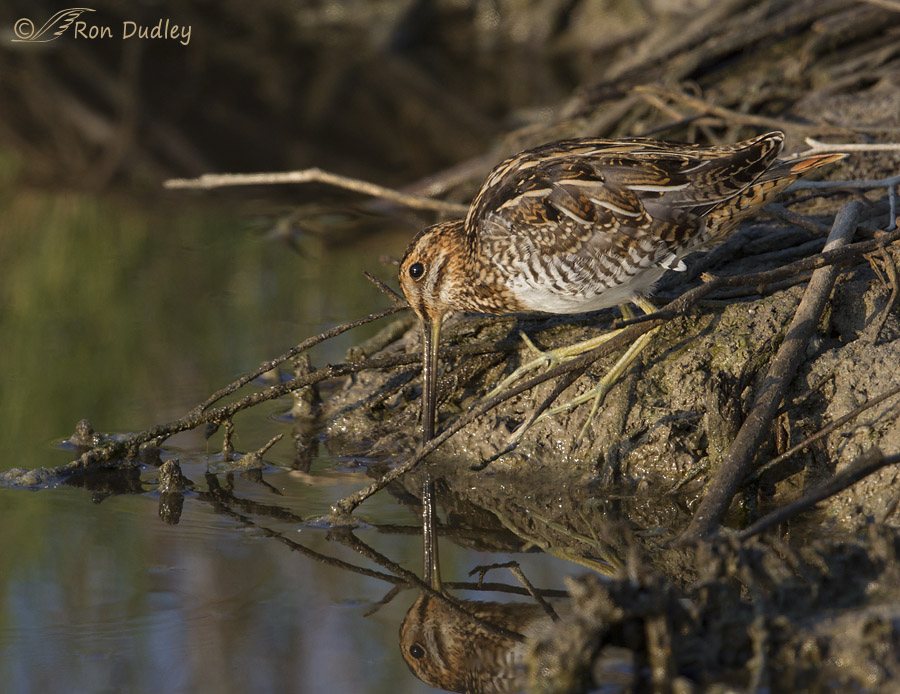
1/1000, f/7.1, ISO 640, Canon 7D, Canon EF500mm f/4L IS II USM +1.4 tc, not baited, set up or called in
going back to feeding. The setting in most of these images is pretty busy but it’s typical habitat for the species and I enjoy the reflection of the head, eye and beak in this one.
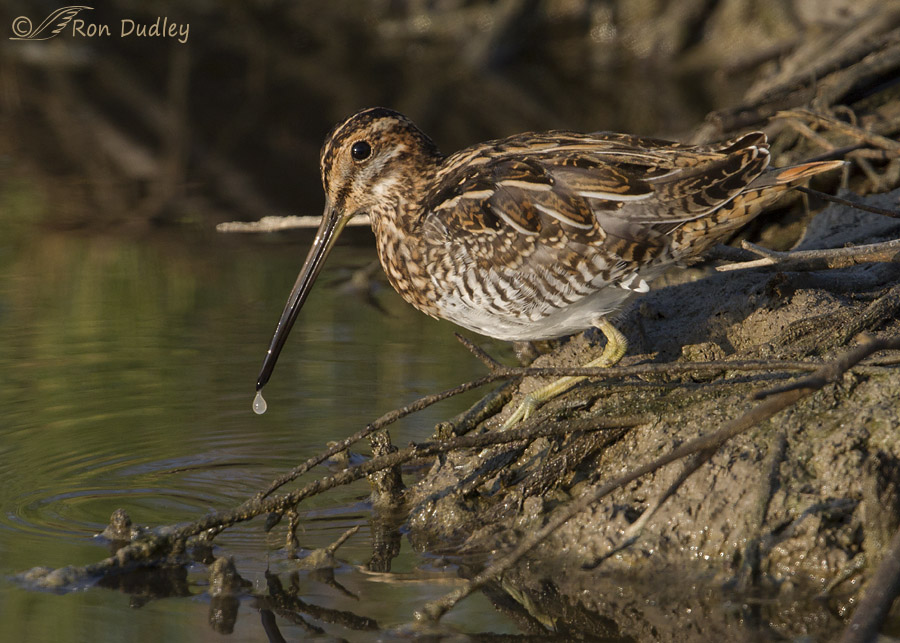
1/1250, f/7.1, ISO 640, Canon 7D, Canon EF500mm f/4L IS II USM +1.4 tc, not baited, set up or called in
The water drop falling from the end of the beak made this image a little special for me even though the bright twig behind the base of the bill is annoying.
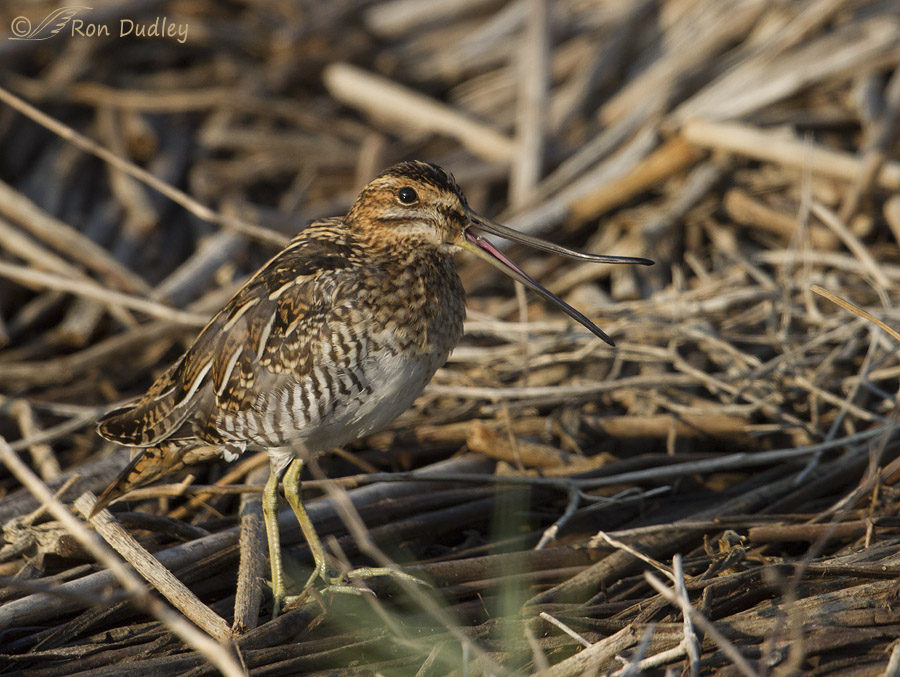
1/2000, f/6.3, ISO 640, Canon 7D, Canon EF500mm f/4L IS II USM +1.4 tc, not baited, set up or called in
When the snipe finished feeding it moved up the bank and yawned and at the same time it flexed its upper bill. Many folks think of the beak as being rigid and inflexible but long-billed shorebirds in particular have quite flexible beaks and can open and close the tips with no movement at the base – a nifty trick when you’re feeding in the mud. That ability is called rhynchokinesis.
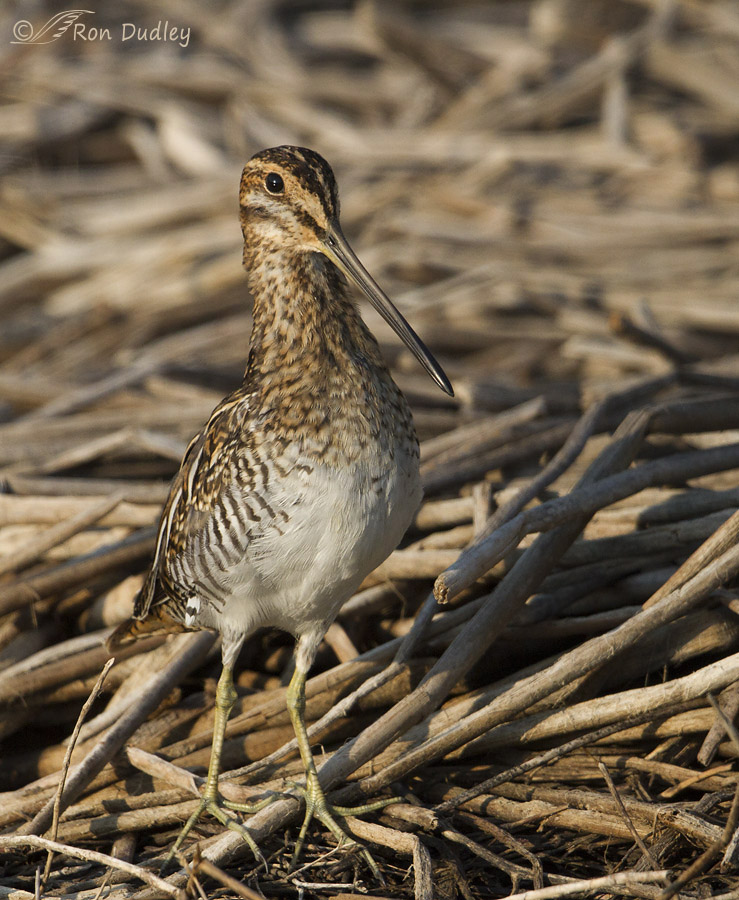 1/2500, f/6.3, ISO 640, Canon 7D, Canon EF500mm f/4L IS II USM +1.4 tc, not baited, set up or called in
1/2500, f/6.3, ISO 640, Canon 7D, Canon EF500mm f/4L IS II USM +1.4 tc, not baited, set up or called in
Snipes are strong, fast fliers with a top speed estimated at 65 mph (105 km/hr) and their huge pectoralis muscle supports that ability. The muscle is 25% of body mass which is the highest of all shorebirds. I think this image gives a pretty good indication of the size of that breast muscle.
In fact snipes are such strong, erratic fliers that hunters have extreme difficulty estimating an aiming lead with their shotguns. The challenges involved in snipe hunting are the origin of the term “sniper”, which refers to a skilled anti-personnel sharpshooter.
Ron


Pretty birds. I’m not familiar with them.
ha, wrong post. The Snipe I’m very familiar with and have sent many a younger scout out looking for. snicker.
This is a wonderful series of a typically very hard to photograph bird. I love the details in some of the shots–the water drop off the end of the bill, the reflections, and in particular the color and texture of the feathers along the back. I was also surprised to see how flexible the Snipe’s bill is (and I love the word to describe it). Thanks for sharing!
Ron;
I really enjoyed these photos and your teachings. Never thought about that term “sniper” before. Neat fact! I didn’t know about
the bill flexibility either. That was very neat to learn!
Priscilla Sokolowski
Wonderful shots Ron. I love the series of poses which gives us an idea of how they feed. Catch-lights, beautiful colors and detail in all. Was fascinated to learn about the flexible bill and sensory perceptions. As for what they are thinking, in this case being a “bird brain” might be a good thing!
In that third shot, the snipe looks as if it is using its beak as a straw.
Loved learning about the flexibility – and the images.
Education and delight. Again.
I love the first image with the reflection. It tempts me to feel sorry for a bird that has a whole ‘nother bird attached to one leg… I was surprised by the twig in the shot with the drop of water – when I looked at it first, the water drop was what caught and held my eye. All the talk about Snipe hunting takes me back to college days, when my fellow students would never believe that there is a bird called a Snipe. The educational aspects of this post are wide ranging. Thanks for teaching me so much.
I just finished researching rhynchokinesis on the web (after checking my calendar to be sure today wasn’t April 1st ):
I have been interested in Birds for almost 50 years and never knew about their flexible beaks. Thanks for the education.
There’s always something new and interesting to learn about birds, isn’t there, Allan? Thank you.
Some difference between a Snipe’s legs and a Sage Grouse’s….
Yup!
Interesting series and comments…esp. about flexibility of bill tip. Love water drop in the second image and how well what you were telling us about reflections ,in what I call the water/mirror in the first, showing so clearly the difference between what we see straight on and what the water “sees from below… I guess that well developed breast is what attracts the hungry hunter…too bad.
I find myself studying reflections often, Patty – just for the fun of it…
Good Morning Ron, Wonderful pictures and as usual your facts make for a special learning experience. Thanks again for your pictures and information.
Thanks very much, Len.
Great pictures again, interesting about the bill.
Thank you, Jo.
Yes I know that feeling when we see a bird who does not fly away and let us take a series of images. I can’t help it but on those occasions I feel like a special bond was created and the only concern I have is to deserve it. Most of the time I don’t because I am still learning…
I am glad that you did it. Beautiful images of a bird that we also have here. It’s name is “Narceja”.
Thank you for the lesson.
“the only concern I have is to deserve it”
I often feel the same way in these situations, Jorge. Sometimes I wonder what I did to earn their trust but I always appreciate it.
That’s an interesting name you have for snipes in Portugal.
Since we’ve been spending so much time at Hueco Tanks I’ve had many opportunities to enjoy the trust of wild creatures – it doesn’t matter if it’s a bird, a lizard, a rock squirrel, a desert cottontail, even a snake. I’ve learned to just treasure those times. And the best part is, when it happens while we’re doing tours, other people get to have the same experience. Those encounters always bring me a sense of wonder, and I love being able to have others share the experience.
What fun! Loved the fact about “snipers.”
Thank you, Patricia.
Absolutely awesome shots Ron! I always thought that cooperative snipe was a true oxymoron. You proved me wrong with your keen eyes and great talent.
Charlotte
“I always thought that cooperative snipe was a true oxymoron”
Well said, Charlotte. Thank you.
Nice Ron! The feather patterns on this bird are stunning enhanced by the light you were able to get on them!
Nancy, that light was pretty special when the bird was in the right spot and facing the right way. I love warm light in my photos and these shots were taken very soon after the sun came up.
A beautiful series, Ron. My favorite is the one where you capture the droplet of water at the tip of his beak. Also, this unskilled viewer totally missed the twig until I read your comment. LOL!!! I was so concentrated on the droplet I had to look back at the photo to see what you were talking about!! It shows me how skilled you are at critiquing your work.
Some accuse me of being too picky about my images, Jo Ann, but I can’t help it. I learned to critique images on a nature photography critique forum and the habit has stuck with me. Generally I think it serves me well but at times I may take it too far…
Ron, I think it’s better to nit pick because it shows you continually strive for the best you can do. And it definitely is reflected in the beautiful quality of your work. And I so enjoy the results of your work.
Pictures like these engenders anthropomorphic ideas about what this bird is “thinking”! Although it would be fun, I won’t go there.
These shots are excellent a great reflection, and I love the colors on this bird they are captured exceptionally.
Dick, I often wonder what they are “thinking” when I’m watching them through my lens. For me it’s unavoidable… Thank you.
Amazing images, Ron!! I have seen them, but have never been able to photograph them!!
Thank you, Gena.